

Aptenodytes. The genus Aptenodytes (from the Ancient Greek a/α 'without' pteno-/πτηνο- "feather" or "wing" and dytes/δυτης "diver")[1] contains two extant species of penguins collectively known as "the great penguins".

[citation needed] Taxonomy[edit] King penguin, Aptenodytes patagonicusEmperor penguin, Aptenodytes forsteri Ridgen's penguin (Aptenodytes ridgeni) is an extinct species known from fossil bones of Early or Late Pliocene age. Combined morphological and molecular data [2] have shown the genus Aptenodytes to be basal to all other living penguins, that is, the genus split off from a branch which led to all other species.
Species[edit] Two monotypic species extant:[5] References[edit] External links[edit] Emperor penguin. The emperor penguin (Aptenodytes forsteri) is the tallest and heaviest of all living penguin species and is endemic to Antarctica.
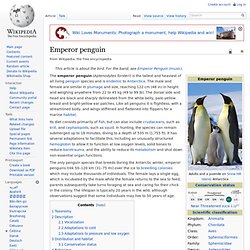
The male and female are similar in plumage and size, reaching 122 cm (48 in) in height and weighing anywhere from 22 to 45 kg (49 to 99 lb). The dorsal side and head are black and sharply delineated from the white belly, pale-yellow breast and bright-yellow ear patches. Like all penguins it is flightless, with a streamlined body, and wings stiffened and flattened into flippers for a marine habitat. Its diet consists primarily of fish, but can also include crustaceans, such as krill, and cephalopods, such as squid. Mammals. Swamphen. Porphyrio is the swamphen genus of birds in the rail family.
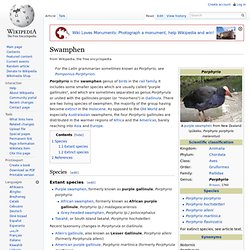
It includes some smaller species which are usually called "purple gallinules", and which are sometimes separated as genus Porphyrula or united with the gallinules proper (or "moorhens") in Gallinula. Purple swamphen. Taxonomy and physical description[edit] There are 13 or more subspecies of the purple swamphen (depending on the authority) which differ mainly in plumage colour.
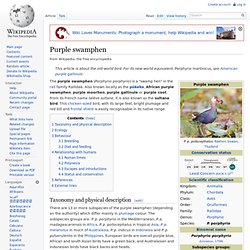
The subspecies groups are: P. p. porphyrio in the Mediterranean, P. p. madagascariensis in Africa, P. p. poliocephalus in tropical Asia, P. p. melanotus in much of Australasia, P. p. indicus in Indonesia and P. p. pulverulentis in the Philippines. European birds are overall purple-blue, African and south Asian birds have a green back, and Australasian and Indonesian birds have black backs and heads.
Pukeko. This article is about purple swamphens in New Zealand.
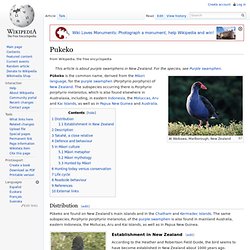
For the species, see Purple swamphen. Puffin. Puffins are any of three small species of alcids (auks) in the bird genus Fratercula with a brightly coloured beak during the breeding season.
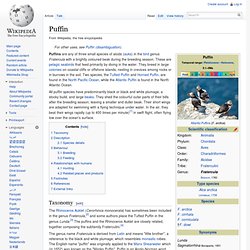
These are pelagic seabirds that feed primarily by diving in the water. They breed in large colonies on coastal cliffs or offshore islands, nesting in crevices among rocks or in burrows in the soil. Two species, the Tufted Puffin and Horned Puffin, are found in the North Pacific Ocean, while the Atlantic Puffin is found in the North Atlantic Ocean. All puffin species have predominantly black or black and white plumage, a stocky build, and large beaks. They shed the colourful outer parts of their bills after the breeding season, leaving a smaller and duller beak. Taxonomy[edit] Atlantic puffin. The Atlantic puffin has a black crown and back, pale grey cheek patches and white underparts.
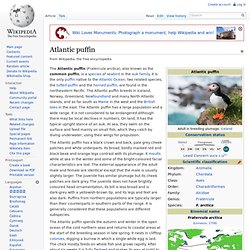
Its broad, boldly marked red and black beak and orange legs contrast with its plumage. Selasphorus. Selasphorus is a genus of hummingbirds.

It contains the following species:[1][2] Scintillant hummingbird, Selasphorus scintillaGlow-throated hummingbird, Selasphorus ardensVolcano hummingbird, Selasphorus flammulaBroad-tailed hummingbird, Selasphorus platycercusRufous hummingbird, Selasphorus rufusAllen's hummingbird, Selasphorus sasinCalliope hummingbird, Selasphorus calliope References[edit] External links[edit] Media related to Selasphorus at Wikimedia Commons. Calliope hummingbird. The calliope hummingbird (Selasphorus calliope) is a very small hummingbird native to the United States and Canada and, during winter, Central America.
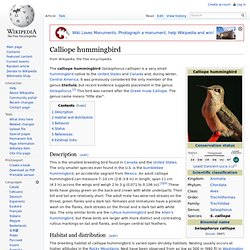
It was previously considered the only member of the genus Stellula, but recent evidence suggests placement in the genus Selasphorus.[2] This bird was named after the Greek muse Calliope. The genus name means "little star". Genus Oryctolagus - definition of genus Oryctolagus by The Free Dictionary. European rabbit. This article is primarily concerned with the wild animal.

For detailed information on domesticated varieties, see Domestic rabbit. For general information on all rabbit species, see Rabbit. The European rabbit or common rabbit (Oryctolagus cuniculus) is a species of rabbit native to southwestern Europe (Spain and Portugal) and northwest Africa (Morocco and Algeria).[3] It has been widely introduced elsewhere, often with devastating effects on local biodiversity. Domestic rabbit. This article is about domesticated European rabbits. For information on the wild variety, see European Rabbit. For general information on all rabbit species, see Rabbit. Genus Erethizon - definition of genus Erethizon by The Free Dictionary.
North American porcupine. The North American porcupine (Erethizon dorsatum), also known as the Canadian porcupine or common porcupine, is a large rodent in the New World porcupine family. The beaver is the only larger rodent in North America. The porcupine is a caviomorph rodent whose ancestors rafted across the Atlantic from Africa to Brazil over 30 million years ago, and then migrated to North America during the Great American Interchange after the Isthmus of Panama rose 3 million years ago.[4] They range from Canada, Alaska, and into northern Mexico.
They are commonly found in coniferous and mixed forested areas but have adapted to harsh environments such as shrublands, tundra and deserts. They make their dens in hollow trees or in rocky areas. Etymology[edit] Genus Suricata - definition of genus Suricata by The Free Dictionary. Meerkat. The meerkat or suricate, Suricata suricatta, is a small mammal belonging to the mongoose family. Meerkats live in all parts of the Kalahari Desert in Botswana, in much of the Namib Desert in Namibia and southwestern Angola, and in South Africa. A group of meerkats is called a "mob", "gang" or "clan". A meerkat clan often contains about 20 meerkats, but some super-families have 50 or more members. Lontra. North American river otter. The North American river otter (Lontra canadensis), also known as the northern river otter or the common otter, is a semiaquatic mammal endemic to the North American continent found in and along its waterways and coasts.
An adult river otter can weigh between 5.0 and 14 kg (11.0 and 30.9 lb). The river otter is protected and insulated by a thick, water-repellent coat of fur. The river otter, a member of the weasel family, is equally versatile in the water and on land. It establishes a burrow close to the water's edge in river, lake, swamp, coastal shoreline, tidal flat, or estuary ecosystems. The den typically has many tunnel openings, one of which generally allows the otter to enter and exit the body of water. Felis. Cat. Walrus. Walrus cows and yearlings (short tusks). Photo courtesy USFWS. Pacific Walrus Species Profile, Alaska Department of Fish and Game. Skip to Main Content Skip to Primary Navigation Skip to Secondary Navigation. Daubentonia. Translingual[edit] Aye-aye. Homo. Homo is the genus of hominids that includes modern humans and species closely related to them. The genus is estimated to be about 2.3 to 2.4 million years old,[1][2] possibly having evolved from australopithecine ancestors, with the appearance of Homo habilis.
Human. Humans began to practice sedentary agriculture about 12,000 years ago, domesticating plants and animals which allowed for the growth of civilization. Orangutan. Orangutans are the most arboreal of the great apes and spend most of their time in trees. Their hair is typically reddish-brown, instead of the brown or black hair typical of chimpanzees and gorillas. Bornean orangutan. Trichechus. [edit] Familia: Trichechidae Genus: Trichechus Species: T. inunguis – T. manatus – T. senegalensis.
Manatee. West Indian manatee. Dugong (mammal genus) Dugong. Right whale. North Atlantic right whale. Petaurus. Sugar glider. Maratus. Maratus volans. Platycryptus (spider) Platycryptus undatus. Opilio. Opilio canestrinii. Sphoeroides. Southern puffer. Periophthalmus. Atlantic mudskipper.